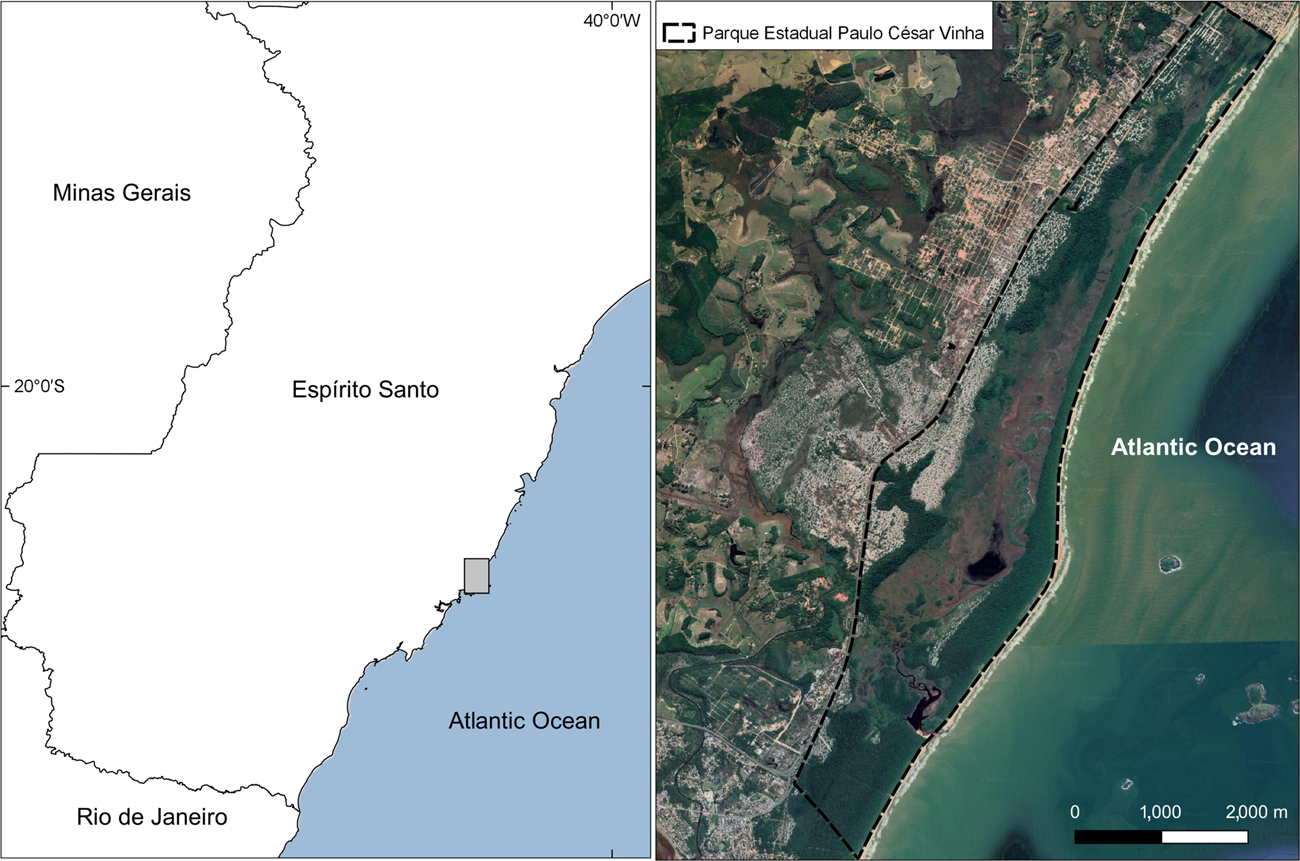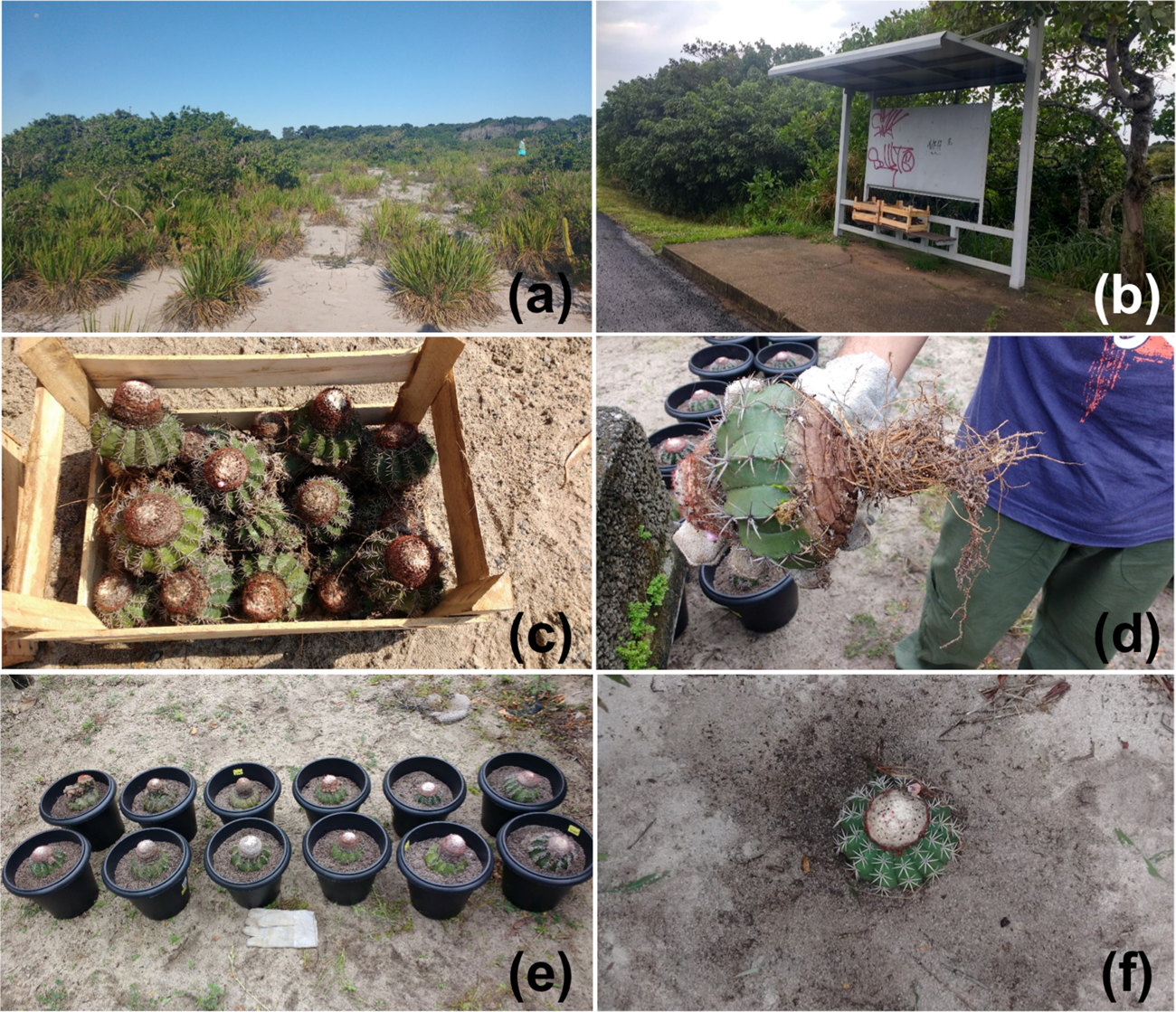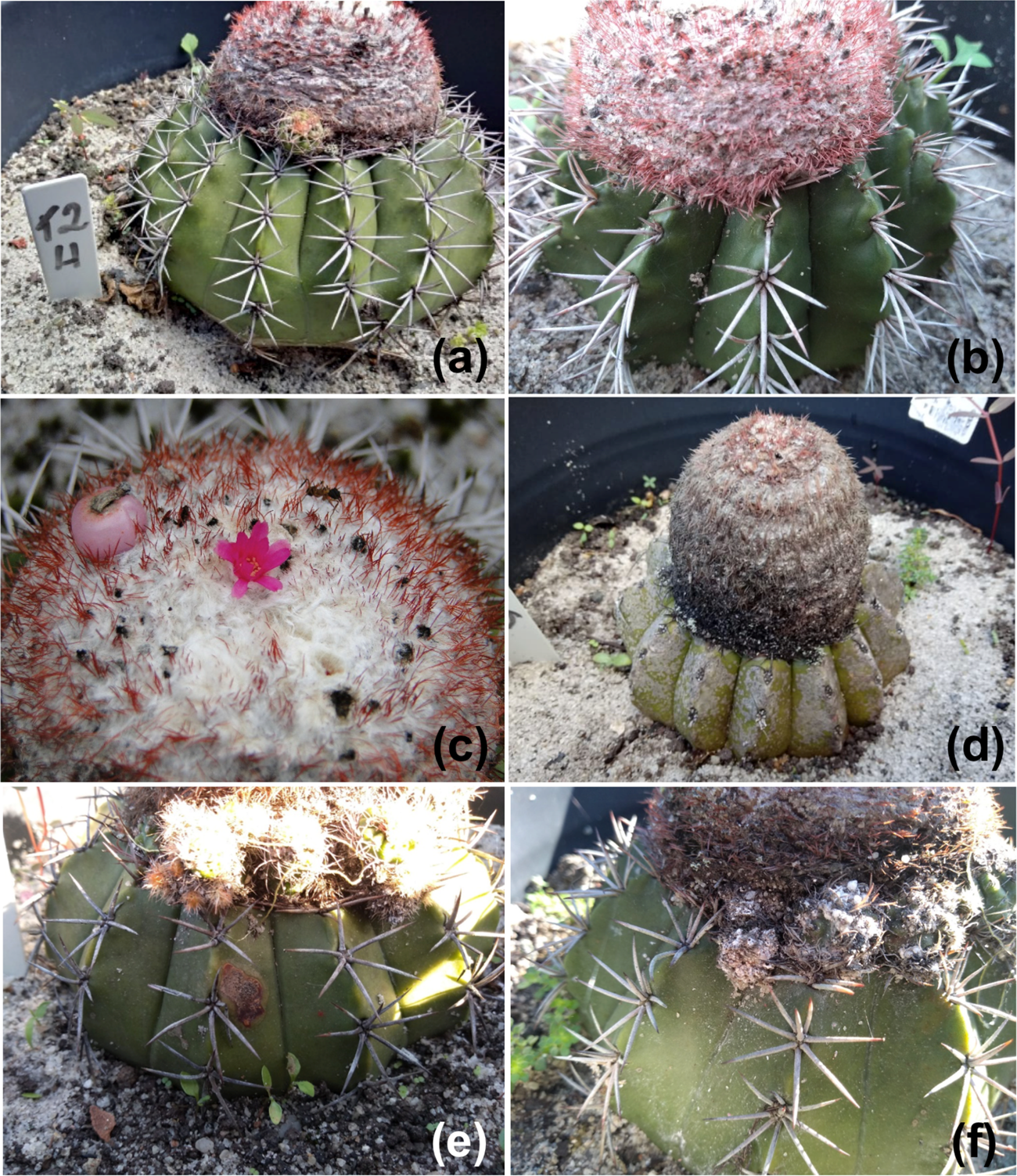The family Cactaceae is one of the most threatened plant families, with 31% of its species threatened to some degree (Goettsch et al., Reference Goettsch, Hilton-Taylor, Cruz-Piñón, Duffy, Frances and Hernández2015). In Brazil, c. 27% of 474 cacti species are threatened (Machado et al., Reference Machado, Menezes, Santos, Pietro, Hering, Barros, Martinelli and Moraes2013; The Brazil Flora Group, 2018). The principal threats are fragmentation and loss of habitat quality, mining and illegal commercialization (Ribeiro-Silva et al., Reference Ribeiro-Silva, Zappi, Taylor and Machado2011). The extraction and illegal trade of globose cacti (e.g. species of Discocactus Pfeiff., Melocactus Link & Otto, Parodia Speg.) are the main drivers of the declines of these species (Machado et al., Reference Machado, Menezes, Santos, Pietro, Hering, Barros, Martinelli and Moraes2013; Cardoso et al., Reference Cardoso, Calvente, Dutra and Sakuragui2018).
Melocactus violaceus Pfeiff., popularly known as coroa-de-frade, is endemic to eastern Brazil (Taylor & Zappi, Reference Taylor and Zappi2018). The species occurs in the Caatinga and Atlantic Forest, in the carrasco, campo rupestre and resting a phytophysiognomies (The Brazil Flora Group, 2018) on the sedimentary coastal plain, and is categorized as Vulnerable on state, national and global Red Lists (Simonelli & Fraga, Reference Simonelli and Fraga2007; Machado et al., Reference Machado, Menezes, Santos, Pietro, Hering, Barros, Martinelli and Moraes2013; Braun et al., Reference Braun, Machado, Taylor and Zappi2017). Although the species is legally protected, it is often sold in urban centers of coastal Brazil (authors, pers. obs., 2018). Extraction is mainly of reproductively mature individuals, which have a developed cephalium (reproductive branch) that increases the species’ ornamental value. Although monitoring results in the seizure of specimens destined for the clandestine market, technical guidance on replantation of cacti into the wild is limited (e.g. Jasper et al., Reference Jasper, Freitas, Musskopf and Bruxel2005). Providing guidance for the reintroduction of this endemic, threatened species is essential to guarantee its conservation (e.g. Godefroid et al., Reference Godefroid, Piazza, Rossi, Buord, Stevens and Aguraiuja2011; Fenu et al., Reference Fenu, Cogoni and Bacchetta2016) through the proper management of seized specimens.
Here, we report the first exploratory study to test conditioning and reintroduction of M. violaceus in restinga vegetation, identify health indicators and discuss effects on the conservation of the species. For this we used 37 adult individuals illegally extracted from Paulo César Vinha State Park in Espírito Santo state, Brazil (Fig. 1), a priority area for conservation of threatened species in eastern Brazil (Brasil, 2018). The plants were being sold by street vendors and were seized by the environmental monitoring agency Instituto Estudual de Meio Ambiente e Recursos Hídricos in September 2018 (Plates 1a–d). At the time of seizure, the plants were bundled together in a box; the roots of some individuals were cut or tied (to facilitate sale), without rhizosphere. After seizure, in view of the lack of a standardized protocol for reintroducing the species into the wild, the Park staff asked us to help, and permitted an exploratory experiment to reintroduce individuals into the Park.

Fig. 1 Location of Paulo César Vinha State Park, Espírito Santo state, Brazil.

Plate 1 (a) Natural habitat of Melocactus violaceus in restinga, (b) location where the seizure was made, (c) seized individuals bundled inside a box, (d) roots tied to facilitate commercialization, (e) individuals cultivated in the greenhouse, and (f) individual reintroduced into the wild.
A few days after seizure, two experiments were started and monitored for 6 months: (1) 25 individuals were conditioned in containers (c. 22 cm tall and 22 cm diameter) containing sand enriched with organic substrate, in a propagation shelter covered by netting with 40% luminosity, no horticultural treatments and only irrigated when there were > 15 days without rain; and (2) 12 individuals were planted directly in a non-inundated open shrub formation of restinga (Pereira, Reference Pereira and Lani2008) were the species naturally occurs, up to 30 cm from the borders of thickets, which, according to field observations and the literature (Hughes et al., Reference Hughes, Jacob and Borba2016), is the environment in which the species normally occurs. To accommodate the roots, a hole 6–12 cm deep was dug, depending on the length of the individual plant's roots. If the roots were tangled, they were untangled and planted in the containers (Plate 1e) or soil (Plate 1f), and then abundantly watered.
Based on our observations of the seized individuals over 6 months, and field observations of natural populations of M. violaceus made during 2016–2019, we identified macroscopic indicators (IUCN, 1998; Fenu et al., Reference Fenu, Cogoni and Bacchetta2016) of plant health. Indicators of good health included maintenance of the greenish epidermis (Plate 2a), formation of new spines (Plate 2b) and production of flowers and fruits (Plate 2c). Indicators of poor health included changes in epidermis colour, varying from yellowish to darkened (Plate 2d) a few weeks before death, and susceptibility to pests (Plates 2e,f).

Plate 2 Macroscopic indicators used to evaluate the health of individuals: (a) maintenance of greenish epidermis, (b) formation of new spines, (c) flower and fruit production, (d) colour change of epidermis, and (e, f) susceptibility to pests.
Of the individuals cultivated in the greenhouse, 76% survived, with the death of 24% plants 3–5 months after planting, and of the plants reintroduced in the restinga, 84% survived, with the death of 16% of plants after 5 months. The production of reproductive structures in both experiments was no different from that in natural populations. Some of the plants that died included those that had roots damaged during extraction or a cut primary root. There was no production of vegetative propagules in either group.
Survival rate was similar to that for species of Cereus Mill., Lepismium Pfeiff., Rhipsalis Gaertn., Parodia Speg. and Opuntia Mill. (Jasper et al., Reference Jasper, Freitas, Musskopf and Bruxel2005). The greater mortality rate of the individuals in the greenhouse suggests that ex situ cultivation may not be as reliable as in situ reintroduction. As mortality only occurred c. 3 months after planting, the species could be kept in a temporary environment, such as a greenhouse, if it is not possible to immediately reintroduce the plant to its natural environment. Although there were no changes in development of reproductive branches, this may probably be related to stress from extraction in the initial months after planting (Schmalenbach et al., Reference Schmalenbach, Zhang, Reymond and Jiménez-Gómez2014). For both experiments, most of the seized individuals that still had roots with a thin layer of rhizosphere survived, which indicates that the integrity of the roots is an important factor for successful plantation.
Although survival was relatively high, it was lower under controlled conditions than when plants were reintroduced into the wild. In a broader context, this suggests a lower chance of survival when the plant is cultivated as an ornamental under inadequate environmental conditions, something that often occurs when individual plants are commercialized illegally.
The success of both cultivation in the greenhouse and reintroduction may serve as a model for other globose cacti that are extracted illegally and then seized by law enforcement officials. Our results indicate that in cases of seizure the individuals need to be planted as quickly as possible, preferentially in the habitat where they naturally occur, which for M. violaceus is along the edges of thickets in restinga. The hole made needs to adequately accommodate the roots and establishment needs to be monitored using indicators of health. When plants cannot be planted immediately into the wild, they could be maintained in containers in a greenhouse until reintroduction is feasible. Subsequent monitoring should evaluate recruitment amongst the reintroduced plants (Cogoni et al., Reference Cogoni, Fenu, Concas and Bacchetta2013; Fenu et al., Reference Fenu, Cogoni and Bacchetta2016). Natural populations produce small vegetative propagules that are wind dispersed (Ribeiro et al., Reference Ribeiro, Meiado and Leal2015). This characteristic, along with the monitoring of health indicators, will contribute to the maintenance of the relictual populations of M. violaceus. Our findings indicate how rapid and effective actions can support the maintenance of a plant species threatened with extinction, and will be of value for decision makers in the processes of environmental licensing, guiding conservation actions in accordance with the Brazilian Alliance for Zero Extinction (Brasil, 2018).
Acknowledgements
We thank Weverson Cardoso for his comments on the text, and the manager and staff of Parque Estadual Paulo Cesar Vinha and Instituto Estadual de Meio Ambiente e Recursos Hídricos for their encouragement and logistical support. This study was financed in part by the Coordenação de Aperfeiçoamento de Pessoal de Nível Superior—Finance Code 001 (MSc scholarship to HAC and PhD scholarship to RTV).
Author contributions
Study design: HdAC, VFD, RTV; fieldwork: HdAC, RTV, LSBC; data analysis: HdAC, RTV; writing: HdAC, VFD, RTV, LSBC.
Conflicts of interest
None.
Ethical standards
All activities conducted during the study were approved by the manager of Parque Estadual Paulo Cesar Vinha. This research was authorized by Instituto Estudual de Meio Ambiente e Recursos Hídricos under license GRN 028R-2015 (process 71911308), and otherwise abided by the Oryx guidelines on ethical standards.




